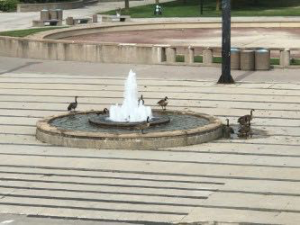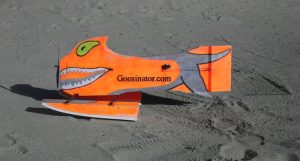Towards the end of the summer in 2015, having just arrived from India, I made my way to the York University campus for the very first time, to see the place where I would be spending the next two years in the Master of Environmental Studies program. The fall term hadn’t begun yet. When I got off the 96A bus, the few people that were on it quickly disappeared into the recesses of air-conditioned buildings and I was left alone to take in my first view of the campus. I looked around and couldn’t see another (human) soul outside, but a gaggle of Canada geese was occupying the fountain, perhaps unintentionally affirming the purpose of the YorkU “Commons”. With my map in hand, I made my way down Campus Walk, around Ross Building and onto Library Lane, briefly stepping off the path to walk around a couple of more geese that had taken up its entire width. As I made my way towards the Health, Nursing and Environmental Studies building, I came upon a second group basking in what used to be open space but has now materialized into the New Student Center. Having never encountered wild geese before, I thought I was witnessing a rare event and assumed that it was the absence of humans that the geese were taking advantage of. When I returned a couple of weeks later to join a group of students on the conventional campus tour, I realized that my first impressions were wrong. As we walked through the campus, now abuzz with activity, the presentation given by our enthusiastic tour leaders was frequently interrupted by our own encounters with geese. It wasn’t the geese that initiated these interactions, but the other students who wanted to stop and take photographs of (and the more daring of the group, selfies with) the geese.
Geese, therefore, became inscribed in my memory of early experiences at the campus and into my continued personal engagement with the space. While other aspects of campus life soon lost their novelty and became part of the ordinary, geese continued to hold my attention for a variety of reasons. I elaborate on some of these reasons in this article in the hope that they might encourage you, the reader, to think differently about the geese on campus.

A few geese cool off at the water fountain in front of Vari Hall. Photo credit: L. Anders Sandberg
Wild birds = nature. But nature ≠ city. So, wild city birds = ….?
The geese that are residents of our campus are classified under the species Branta canadensis, but also belong to that unsettled category of ‘urban wildlife,’ which includes plants and animals that have learned to live (and thrive) in human modified, urban landscapes. Urban wildlife are ideal subjects to think with while questioning the problematic, but tenacious, distinctions between nature and society, wilderness and city. Nature, that pure and stable place, is usually defined as removed from and in contrast to urban society. In other words, nature is what the city is not. A range of work by scholars in various fields has brought the dubiousness of this distinction to our attention. But geese constantly bring it to our attention too: their frequent transgressions into human lives (and property), and their ability to flourish in urbanized areas trouble the discursive—and sometimes physical—boundaries between nature and society.
What is the place of geese on campus? And who gets to decide? These are questions worth pondering when we think not just of geese, but others who live in, work and pass through the space, not all of whom arrive with academic ambitions. What does the space mean to them? Does it matter?
If we look at how urban wildlife is treated in different contexts, we find that depending on how many they are and how they behave, they are treated either as revered objects of nature—meant to be preserved and looked at from a distance—or pests that are meant to be controlled, disciplined and managed. What if we instead recognize them as subjects and environmental citizens that sharethe space with us? One way to do this is to acknowledge that humans are not the only actors that use or even shape a place. There is a multitude of nonhuman constituents at work too, each with their own agency to influence each other and their surroundings[1]. Without geese, our campus might have been quite different: ecologically, materially, and even socially. To see them as members of such a collective, therefore, we need a different approach: We need to think with them, and conversewith them. But how do we converse with geese? To begin, we might look to the meaning of the word ‘conversation.’ Its etymology shows that its older, less frequently used meaning is “living together with, keeping company with, or having dealings with others” and also a “manner of conducting oneself in the world.”[2] These meanings have connotations beyond mere verbal communication and can help us be attentive and open to geese, be curious about them, in order to make space for them—without smothering or disciplining them.

This goose by Stong Pond first seemed curious about my presence and came towards me, but before getting too close turned around and walked off in the opposite direction. It encouraged me to think that this was the beginning of a ‘conversation,’ and I resolved to return to the same spot at another time. But my future attempts were cut short by a combination of inclement weather and the disappearance of the geese altogether from their usual site – a strong attestation of nonhuman agencies at work. Image credit: Author.
Tracing lines of flight: from wilderness to city
Geese have become such a common part of our urban landscape that it is hard to imagine that not so long ago they were a rare sight. At the turn of the 20thcentury, Canada geese were nearly extinct due to unregulated hunting during the 1700s and 1800s across the North American continent. Then, through the 1940s and 50s, a number of conservation measures were carried out, including captive breeding, rearing and re-introduction into the wild, along with changes to hunting laws[3].These efforts were extremely effective and geese numbers across North America rapidly revived, resulting in their current, abundant, success. In some areas today, they are even considered as pests.
What makes geese successful is their ability to adapt their behaviors and habits to human-modified landscapes. They tend to prefer open spaces with good visibility, so are drawn to lawns and parks in cities, especially near water. Their seeming indifference to living and moving about in close proximity to humans and the absence of their human-wary predators and (human) hunters, offer them added advantages in these landscapes. The interbreeding of migrant subspecies with non-migrant subspecies during the period of captive rearing and reintroduction has resulted in many local populations of geese having ceased migrating altogether. The presence of food and water throughout the year – made possible through anthropogenic processes—enables them to live in the same place even through the winter.
Geese are now powerful actors in co-creating urban ecologies. Through their (inter)actions and movements, their grazing, grubbing and trampling, their knowledge-bearing activities and disease-bearing feces, they link their social and material histories in intricate ways with our own. On our own campus, resident geese potentially transport and disperse water- and land- plants. At Stong Pond, their excrement, while toxic to some organisms, provide important nutrition for others, who in turn support other life forms. Large open spaces with lawns instead of trees, ornamental ponds and fountains—while hostile environments to some wildlife and distasteful campus features to some humans—are loved by geese who are perhaps not their intended users. What is seen as aesthetically desirable by the university’s designers is ecologically desirable by the geese, and so they work to reinforce each other.

Buildings at different locations on campus and of different heights serve as potential vantage points or resting spots for geese and other birds, such as this pair, perched atop the Farquharson Life Sciences building. Image credit: Author.
Picture a flock of geese flying above a forest, and an eager birdwatcher tracing the V of their silhouetted bodies gliding gracefully across the sky with her binoculars. Now picture a goose at a park, skulking about a picnicker’s table, waiting for an opportunity to steal a piece of bread. In this transition from rare, wild birds to common city residents, Canada geese have steadily lost their wilderness credentials. The hushed reverence for a glimpse of these birds in wild ‘nature’ has been replaced with a charge-sheet of a long list of misdemeanours in ‘society’. These include: damaging grass and other plants; fouling footpaths, beaches and green spaces with droppings; contaminating water bodies with parasites; displaying aggressive behavior towards humans and pets; causing crop damage; and noise disturbance[4]. The same behavior that is accepted as natural in the wild—feeding, defecating, rearing and protecting young ones, and vocalizing—become disruptions when they are performed in the city. The transformation in our approach towards them has also been accompanied by a change in our language. Geese do not seem to warrant the same violent vocabulary common to dealing with ‘vermin’ such as insects and rodents. Nor have they earned the protection directed towards rarer members of wildlife. Rather, the language used in ‘management recommendations’ is an uneasy mix of treating them as wild animals andurban nuisances. Consider how the Canadian Wildlife Service justifies the hunting of geese: “Hunting is the most important source of mortalityfor adult geese.”[5] Closer to home, at Stong Pond, Groundskeeping staff have resorted to using “harmless blasts of sound” to keep more geese than is considered ideal from settling by the water. Their rationale? “Overpopulation of the geese presents a health and safety risk to people, pets, other wildlife and causes damage to property.”[6] By not directly harming the geese, they claim, they are creating an “unwelcome environment.”

From being addressed as problems that need to be dealt with, to standing in as natural subjects of anthropomorphic projections of personality, geese are subject to a wide range of social judgment and ethical relationships.
The image above is of a ‘goosinator’, a motorized, remote-controlled device designed to haze geese and prevent them from settling down in an area. The company’s tagline reads “Finally! A proven method that effectively gets geese off your property quickly and effectively.” Image credit: goosinator.com. Below is a photograph of a goose pair nicknamed “The Chesters” by a member of Love Canada Geese, a group of Canada geese enthusiasts and animal rights advocates. On their website the image caption reads, “Mrs. Chester is building her nest while her loving ‘hubby’ hovers proudly beside her.” Image credit: lovecanadageese.com.

Returning to the question of what is the place of geese on campus, and on whose terms this is decided, what does the use of such management measures tell us about our relationship with geese? One group of students used an innovative approach to challenge the claim that the noise cannons used by groundskeeping were harmless. They compared the method and purpose of using loud sounds to scare and discipline geese to the violence of colonization, reminiscent of a war, where the screaming and fleeing geese are seen as its victims. As an experiment, the students taped the sound of the blasts and the reacting geese and replayed it to unsuspecting staff and students, who responded in confusion, fear and surprise. Within the confines of their classrooms and offices, the exterior land- and sound-scapes had been erased. The students report that foregrounding the experiences of geese to their colleagues and their ensuing reactions created “beautiful pedagogical trouble”: it mixed up otherwise separate realms and made real the troubling engagements with geese on campus[7].
Paying careful attention to these urban wilds can help us appreciate the complexity of relationships that unfold when geese, trees, people, microbes, noise cannons, and people happen to be in the same place at the same time. We can converse with and about them without placing them in strictly bound ‘natural’ and ‘social’ categories. Instead of seeing geese as another mute element of the background, we can learn to see them as co-actors in networks that draw human, nonhuman, biophysical, and material elements into a messy collective—living, working, waddling, writing, talking and honking in the space that we call the university campus.
Questions:
- What have your own experiences with geese on campus been? Have these experiences been different or similar to your encounters with other wildlife?
- What would a map of the campus look like if geese were to re-draw it? Which areas do you think matter most to them, and which are redundant? What does that tell us about how we occupy the same space but use it differently?
- Should we include geese and other nonhuman co-habitants of the space in making decisions about what we want to do with the space? If so, how?
- What is your idea of ‘conversing’ with someone/thing when spoken language cannot be the medium of conversation?
Endnotes:
[1] Environnent Canada, 2010.
[2] Environnent Canada, 2010. Emphasis added.
[3] York University, 2017
[4] Hanson, 1997.
[5] Hinchliffe, 2008.
[6] Online Etymology Dictionary, n.d.
[7] Stella, 2016. You can read the paper here.
References
Environment Canada. (2010). Handbook, Canada and Cackling Geese: management and population control in southern Canada. Retrieved August 10, 2018 from https://www.ec.gc.ca/mbc-com/6D2B893B-C671-41AF-8439-713305DB384C/Handbook_Canada_Cackling_Geese_e%5B1%5D.pdf.
Hanson, Harold C. (1997). The Giant Canada Goose (2nd ed.). Southern Illinois University Press.
Hinchliffe, S. (2008). Reconstituting Nature Conservation: Towards a Careful Political ecology. Geoforum, 39(1), 88–97.
Online Etymology Dictionary. (n.d.). ‘Conversation’. Retrieved November 28, 2016, from http://www.etymonline.com/index.php?term=conversation.
Stella, M. (2016). Alternative Campus Tour: Sound as a tool of critical pedagogy of place. Conference paper. Retrieved on August 29, 2018 from https://www.researchgate.net/publication/322695725_Alternative_Campus_Tour_SOUND_AS_A_TOOL_OF_A_CRITICAL_PEDAGOGY_OF_PLACE?enrichId=rgreq-3bc4db8f9abfefe056ffd313e2719e9f-XXX&enrichSource=Y292ZXJQYWdlOzMyMjY5NTcyNTtBUzo1ODY1NDk0MTQ2MjExODRAMTUxNjg1NTY4NjE5Mg%3D%3D&el=1_x_2&_esc=publicationCoverPdf.
York University. (2017). “Goose management program uses harmless blasts of sound”. Retrieved March, 2017, from http://yfile.news.yorku.ca/2017/03/15/goose-management-program-uses-harmless-blasts-of-sound-2/.
Biography
I was a student of the Master of Environmental Studies program at the Faculty of Environmental Studies between 2015 and 2017. For my Master's project, I had the opportunity to explore knowledge-making practices in migratory bird conservation. I previously worked in India, where I am from, with a non-profit conservation and environmental justice NGO. Animals, and people who study animals, have always been a central part of my life; and they continue--in their creative and cunning ways--to challenge the way I think about nature and human-animal relationships. My research interests include the practice and politics of wildlife conservation, political ecology and science and technology studies.



